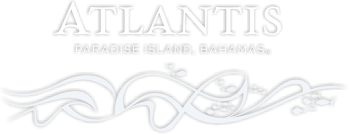| |
 Before
getting their first look at Paradise Island, vacationers, may not
realize the unique opportunity they’ll have to explore a truly
extraordinary collection of marine habitats and aquarium
exhibits—lagoons, caves, coral formations and breathtaking underwater
ruins designed to showcase exotic marine life ranging from dolphins and
sea lions to sharks, rays, barracuda, to piranha, eels and even
endangered alligator gar. Atlantis Resort host the largest such exhibit
in the Caribbean and one of the largest in the world … encompassing 14
lagoons, eight million gallons of salt water and more than 50,000
aquatic animals representing over 250 marine species. Before
getting their first look at Paradise Island, vacationers, may not
realize the unique opportunity they’ll have to explore a truly
extraordinary collection of marine habitats and aquarium
exhibits—lagoons, caves, coral formations and breathtaking underwater
ruins designed to showcase exotic marine life ranging from dolphins and
sea lions to sharks, rays, barracuda, to piranha, eels and even
endangered alligator gar. Atlantis Resort host the largest such exhibit
in the Caribbean and one of the largest in the world … encompassing 14
lagoons, eight million gallons of salt water and more than 50,000
aquatic animals representing over 250 marine species.
The Dig
There’s only one
place in the world where you can embark on a journey through the streets
and tunnels of the fabulous lost city of Atlantis while touting stunning
marine life exhibits. Reflecting the tunnels and thoroughfares of the
lost continent; Paradise Island’s The Dig features habitats for 100
venomous Indo-Pacific Ocean Lionfish, 500 piranhas, iridescent jellyfish
and six-foot Moray Eels. There are special environments nine species of
enormous groupers. And in separate, smaller “Jewel Habitats,” multitudes
of brilliantly colored tropical fish dwell. Resort guests should plan
ahead and remember not to miss the interactive touch tank
aquarium—filled with conch, starfish, sea urchins, sea cucumbers, crabs
and horseshoe crabs—and designed to encourage vacationer interaction.
It’s a once in a lifetime experience.
Lobster Exhibit - Once used by the Atlanteans for waste
disposal, this site has now been taken over by spiny lobster
Panulirus argus and slipper lobster Scyllarides aequinoctialis.
These reef dwellers grow by molting. This occurs when the shell, or
exoskeleton, splits apart, exposing the new shell that has developed
under it.
Lionfish Exhibit - Once the end of a main street, lionfish
Pterois volitans, spotted scorpion fish Scorpaena plumieri,
and long-spine urchin Diadema antillarum now call this enclosed
area home. Native to the Indian and Pacific Oceans, lionfish have become
an invasive species in The Bahamas, outcompeting native species of fish.
Jewel Tank Exhibit - Atlanteans placed written wishes in
the holes within the wall behind this ancient icon. Today, these same
holes are home to Cuban hogfish Bodianus pulchellus, queen
angelfish Holacanthus ciliaris, and rock beauty Holacanthus
tricolor.
Grouper Exhibit - The goliath grouper Epinephelus
itajara and the Nassau grouper Epinephelus striatus now make
their home in what was once a part of the lab. The goliath grouper can
grow to more than 8 ft. in length and weight more than 800 lb. Groupers
gather annually in huge numbers to spawn on ancestral grounds.
Seahorse Exhibit - This small chamber now houses our
seahorse Hippocampus erectus exhibit. When reproducing, the female
seahorse deposits her eggs inside the male’s brood pouch. The male then
carries the developing babies until they are born. Seahorses have become
endangered for a variety of reasons, including loss of habitat.
Clownfish Exhibit - Made famous by the blockbuster movie
Finding Nemo, the clownfish Amphiprion ocellaris and anemones
Condylactis gigantea are housed in what is said to be a storage room
that led to the back alleyways of the City of Atlantis.
Jellyfish Exhibit - These two rooms are believed to be
storage chambers used to store light-sensitive navigational documents.
It is the perfect setting to view the purple-striped jelly Chrysaora
melanaster and the moon jellyfish Aurelia aurita. These
animals are 98% water and do not have a brain, central nervous system or
eyes.
Moray Eel Exhibit - This storage room for Atlantean pots
and urns has become the perfect home for green moray eels Gymnothorax
funebris. Eels are actually fish. The green color of these animals
is produced by a yellow mucous layer, which overlays the darker blue
skin. They grow to an impressive length of 6 ft.
Piranha Exhibit - This vault-like chamber is where the
Atlanteans would have stored their treasures and scientific records.
Contrary to movie story lines, piranhas Pygocentrus nattereri do
not mindlessly attack people and other animals as they enter the water.
When hungry, these fish tend to attack weak and injured animals.
Ruins Lagoon
Located in Paradise
Island’s Royal Towers, and viewable from within The Dig or the lower
level of the Great Hall of Waters, the Ruins Lagoon is adorned with
artifacts inspired by ancient Atlantis, and is home to more than 20,000
deep reef and pelagic fish. These open-water specimens include a variety
of jacks, snappers and spiny lobster. The 2.7 million-gallon marine
exhibit is a magnificent display of rare sleek sharks and rays. Resort
guests can snorkel in this unbelievable setting during one of our
exciting Sea Keepers Adventurers programs – Aquarist for a Day and
Snorkel the Ruins. Marine Life in residence: Crevalle Jacks Caranx
hippos, Cottonwick Grunts Haemulon melanurum, Zebra Sharks
Stegostoma fasciatum, Spotted Eagle Rays Aetobatus narinari
and more.
Predator Lagoon and Mayan Temple Lagoon
Located at Paradise
Island’s Mayan Temple, resorts guests can see Great Hammerhead Sharks
Sphyrna mokarran, Smalltooth Sawfish Pristis pectinata,
Barracudas, Blacknose Sharks Carcharhinus acronotus, Caribbean
reef sharks Carcharhinus perezi and Nurse sharks Ginglymostoma
cirratum by taking an exhilarating inner tube ride through a clear
underwater tube – or from the dry comfort of the surrounding deck via
panoramic windows. Vacationers can also sign-up to "Walk with the
Sharks" underwater with specially designed underwater helmets. It’s a
rare habitat that’s not to be missed.
Cenote
Inspired by one of
the innumerable natural wonders of the Yucatán, the legendary cenote
sagrado—underground caverns and pools that were sacred to ancient Maya
because they represented the rain god Chaac. On Paradise Island the
Cenote is a habitat for pacu, redtail catfish Phractocephalus
hemioliopterus, cichlids and the endangered Alligator Gar
Atractosteus spatula. Resort guests can plunge down the Power
Tower's Abyss water slide and actually splash down into the cave’s
environment.
Estuary Lagoon
Paradise Island’s Estuary
Lagoon serves as transitional home for many immature Atlantis marine
specimens. A secure shallow-water nursery environment where Southern
stingrays Dasyatis Americana and Bonnethead sharks Sphyrna
tiburo are spend their early years in safety. For guests of the
resort – especially younger ones – it’s a unique educational opportunity
and a chance to observe these species as newborns.
Reef Lagoon
The Reef
Lagoon is a fascinating marine habitat home for Paradise Island’s
bottom-dwelling nurse shark residents. And an opportunity for resort
guests to get an up close and educational look at a collection of marine
animals who protect Atlantis’ myths and treasures.
Hibiscus Lagoon
Paradise Island’s
Hibiscus Lagoon is an incredible underwater world; a meandering home to
Green sea turtles Chelonia mydas, Hawksbill turtles
Eretmochelys imbricata, Triggerfish, and Bermuda chubs Kyphosus
sectatrix. It represents a special opportunity for vacationers to
explore breathtaking marine habitats and visit these exotic marine
animals.
Seagrapes Lagoon
Located just steps away
from Paradise Island’s Beach Tower, the Seagrapes Lagoon is a
500,000-gallon marine habitat housed within a Bahamian cave where exotic
reef fish and gentle rays shift and blend; creating a kaleidoscope
effect that’s been known to take a vacationer’s breath away. Viewing
windows provide close-up sightings of sea life ranging from French
Grunts Haemulon flavolineatum, Queen Angelfish Holacanthus
ciliaris, Blue Parrotfish Scarus coeruleus and Rainbow
Parrotfish Scarus guacamaia to Butterflyfish and even
Squirrelfish. And during feedings, resort guests have the opportunity to
watch the resident stingrays being fed by hand.
Stingray Lagoon
Take a few steps
outside Paradise Island’s Beach Tower and you’ll find yourself at the
sandy, shallow, Stingray Lagoon; an exquisite marine habitat that
affords resort guests an up-close look at Southern stingrays Dasyatis
americana and Cownosed rays Rhinoptera bonasus. During
feeding times, vacationers even have the opportunity to touch and feed
the graceful creatures. It’s chance for close up marine life interaction
that’s not to be missed.
Royal Ray Lagoon
Resort guest
will have a wide range of choices when it comes to entertainment or
educational tour options during their stay on Paradise Island. One no
vacationer should miss out on the opportunity to visit is Paradise
Island’s Royal Ray Lagoon—home to two local species of stingrays:
White-spotted Eagle Rays Aetobatus narinari and Southern
stingrays Dasyatis americana. Located outside Royal Towers, along
either side of the Royal Walk.
Water's Edge
During their stay on
Paradise Island, resort guests have a wide range of choices when it
comes to entertainment or educational tour options. The opportunity no
vacationer should miss out on to visit is Paradise Island’s Water’s Edge
Lagoon—a shallow and tranquil marine habitat inhabited by sea life such
as Bone fish Albula vulpes, Bonnethead sharks Sphyrna tiburo,
Blacknose Sharks Carcharhinus acronotus and Cownose rays
Rhinoptera bonasus. It’s a sea life experience you won’t soon forget.
Source: official site of
Atlantis (2013)
|
|

